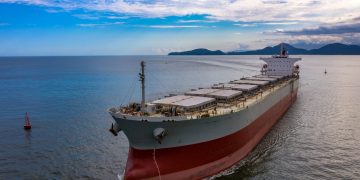As there are ongoing discussions around the potential expansion of the European Union Emissions Trading System (EU ETS), MSC provided an update on how these changes may impact ship operations and its clients.
Aiming to incentivize decarbonization efforts, the EU ETS requires companies to obtain allowances that equal their emissions above the cap at the end of the year. The price of such allowances may fluctuate depending on supply and demand factors, the company explained.
There are currently at least two paths that policymakers are considering. The European Commission has proposed a phased-in approach for the shipping industry over the next four years, beginning on 1 January 2023. Meanwhile, the Parliament has recommended 100% application from the start. The final start date for coverage has yet to be determined, as the legislative process is still ongoing.
The extension of the existing system to shipping would include all emissions from ships calling at an EU port for voyages within the EU (intra-EU) as well as 50% of the emissions from voyages starting or ending outside of the EU (extra-EU voyages), and all emissions that occur when ships are at berth in EU ports. Another pending proposal being debated in the EU institutions would extend the geographical scope of the emissions reporting area to ports within 300 nautical miles of EU waters.
As other industries do today, MSC and other ship operators would purchase and surrender ETS emission allowances, or EU Allowances (EUAs), for each ton of CO2 emissions reported under the scope of the system.
Should the EU fully implement its plans, we anticipate higher operating costs in order to be compliant. We therefore plan to pass on the cost of compliance, as we have done with other forms of environmental regulatory costs in the past. This will depend on the price of the EUAs and on whether the shipping industry’s involvement is phased-in over several years, or required 100% from day one.
… MSC stated, explaining that it will make calculations beginning on the day the system is introduced by the EU and will review them monthly, based on a benchmark public index for EUA prices. Each trade, comprising a number of MSC services, will have its own charging structure for inbound and outbound cargo to compensate for the new costs from the need to acquire these allowances.
Compliance cost examples
As an example, based on an EUA price of EUR90 per ton of CO2 applied with a 100% obligation, we would envisage adding the cost on our Far East to North Europe trade of EUR69 per TEU for dry containers and EUR208 per FEU for reefer containers. North Europe to Asia, the cost would be EUR37 per dry TEU and EUR110 per reefer FEU.
Indicative EU ETS compliance costs
Based on an EUA price of EUR90 per ton of CO2 applied with a 100% obligation
| Trade | EUR est. cost per dry TEU | EUR est. cost per reefer FEU |
| Intra-Med Short Sea Trade | 78 |
233 |
| North/South Europe – NEU to Greece/Turkey | 167 | 500 |
| USA/Canada to Europe | 32 | 97 |
| Europe to USA/Canada | 83 | 248 |
| S. America (East Coast) to Europe | 159 | 478 |
| Europe to S. America (West coast) | 66 | 197 |
| S. America (West Coast) to Europe | 116 | 348 |
| Europe to S. America (West coast) | 75 | 226 |
| Far East to Mediterranean/NWC Europe | 69 | 208 |
| Mediterranean/NWC Europe to Far East | 37 | 110 |

































































